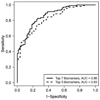Biomarkers in acute lung injury--marking forward progress
- PMID: 21742222
- PMCID: PMC3134784
- DOI: 10.1016/j.ccc.2011.04.001
Biomarkers in acute lung injury--marking forward progress
Abstract
This article reviews the state of the art regarding biomarkers for prediction, diagnosis, and prognosis in acute lung injury. Biomarkers and the goals of biomarker research are defined. Progress along 4 general routes is examined. First, the results of wide-ranging existing protein biomarkers are reported. Second, newer biomarkers awaiting or with strong potential for validation are described. Third, progress in the fields of genomics and proteomics is reported. Finally, given the complexity and number of potential biomarkers, the results of combining clinical predictors with protein and other biomarkers to produce better prognostic and diagnostic indices are examined.
Copyright © 2011 Elsevier Inc. All rights reserved.
Figures




References
-
- Hudson LD, Martin TR. Predicting ARDS: problems and prospects. Lancet. 1997 Jun 21;349(9068):1783. - PubMed
-
- Ventilation with lower tidal volumes as compared with traditional tidal volumes for acute lung injury and the acute respiratory distress syndrome. The Acute Respiratory Distress Syndrome Network. N Engl J Med. 2000 May 4;342(18):1301–1308. - PubMed
-
- Biomarkers and surrogate endpoints: preferred definitions and conceptual framework. Clin Pharmacol Ther. 2001 Mar;69(3):89–95. - PubMed
-
- WHO International Programme on Chemical Safety. Biomarkers in risk assessment: validity and validation. [Accessed 20th October, 2010];2001 http://www.inchem.org/documents/ehc/ech/ech222.htm.
Publication types
MeSH terms
Substances
Grants and funding
LinkOut - more resources
Full Text Sources
Other Literature Sources

